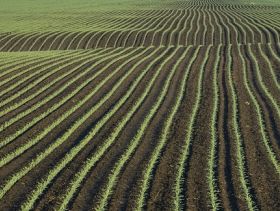 he corn market appears to be having difficulty anticipating the likely size of the 2013 US crop. Over the past three weeks, December 2013 corn futures have traded from a low of $5.12 to a high of $5.735 as production expectations continue to unfold.
he corn market appears to be having difficulty anticipating the likely size of the 2013 US crop. Over the past three weeks, December 2013 corn futures have traded from a low of $5.12 to a high of $5.735 as production expectations continue to unfold.Production uncertainty is the result of uncertainty about both the likely magnitude of planted acreage and yield prospects associated with late planting of the crop in many areas. Nationally, an estimated 46 per cent of the crop was planted as of 15 May this year, compared to an average of 72 per cent in the previous 34 years.
The largest per centage of the acreage remained unplanted as of 15 May this year since 1995. An estimated 9 per cent of the acreage was still to be planted as of 2 June. More information about planted and harvested acreage of corn for grain will be available with the USDA’s Acreage report to be released on 28 June. Those estimates are based primarily on data collected during the first two weeks of June.
The USDA conducts two surveys during that period. One is a probability area frame survey consisting of about 11,000 parcels of land for all crops included in the survey. The parcels average about one square mile in size and enumerators contact operators within the sampled parcel to account for the crop acreage. The second survey is a probability sample of about 70,000 farm operators for all crops. Operators in this sample are contacted by mail, internet, telephone, or personal interview to obtain information on planted and harvested acreage.
Expectations for the estimates of planted and harvested acreage of corn appear to be in a wide range for at least two reasons. First, some analysts reportedly think that the USDA’s March survey of prospective corn plantings resulted in an under-estimate of farmers’ actual planting intentions. Under normal planting conditions, then, some would have expected to see a larger estimate in the June report.
The second and more important reason for the wide range of expectations stems from late planting. Estimates of the number of acres that were intended for corn that have been or will be switched to another crop or not planted at all vary considerably. The 28 June report will shed some light on that issue, but the larger than normal amount of unplanted acreage during the survey period suggests the report will still reflect intentions in some cases.
There is also a wide range of yield expectations for the 2013 corn crop. The variation stems from the difficulty of assessing the likely impact of the combination of late planting, flooding, and replanting in some area and timely planting and favorable growing conditions in other areas. Most appear to expect an average US yield below trend value in 2013.
The calculation of trend value and the expected shortfall from trend, however, vary widely. Yield prospects will take on more importance following the 28 June Acreage report. Weather conditions and weekly crop condition ratings will provide some indication of yield prospects, although there has not been a strong correlation between crop ratings and yield in recent years.
The price implications of unfolding production prospects will need to be evaluated in terms of the expected size of the market for US corn during the 2013-14 marketing year. In the May 10 WASDE report, the USDA projected the size of the market at 12.92 billion bushels under conditions of ample supplies and moderate prices. That projection is 1.785 billion bushels larger than expected consumption during the current marketing year characterized by small supplies and high prices.
Large increases in consumption are expected in each major category of use—ethanol, exports, and feed and residual use. The largest per centage increase (73 per cent) is expected for exports while the largest absolute increase (925 million bushels) is expected for feed and residual use. At 5.35 billion bushels, the projection of feed and residual use is the largest since 2007-08.
The large projection reflects an expected increase in livestock feeding rates, not an increase in the number of grain consuming animal units. The expected higher feeding rate reflects a combination of lower feed prices and larger residual use associated with a very large crop. The projection appears generous and the forecast of residual use would likely decline with a smaller crop forecast, even if prices are at the projected level.
A large number of acreage, yield, consumption, and price scenarios are still possible at this time. Importantly, there is room for a much smaller crop than the early prospects of 14 billion bushels before rationing would be required during the upcoming marketing year. A crop of 13 billion bushels would be sufficient to meet expected needs at current new crop price levels. If harvested acreage is near 85.5 million acres (four million below the early forecast), as an example, a crop of that size would require an average yield of 152 bushels, about 10 bushels below trend value. The USDA will provide updated projections in the 12 June WASDE report.





